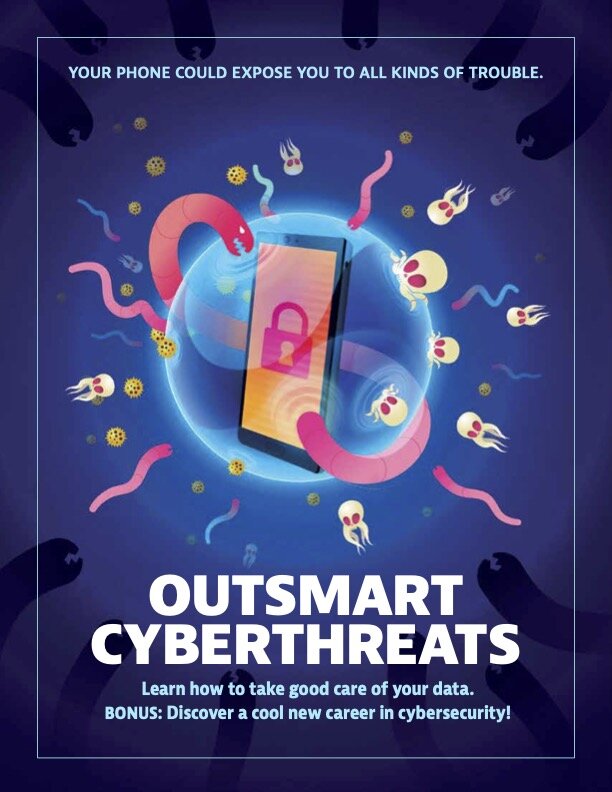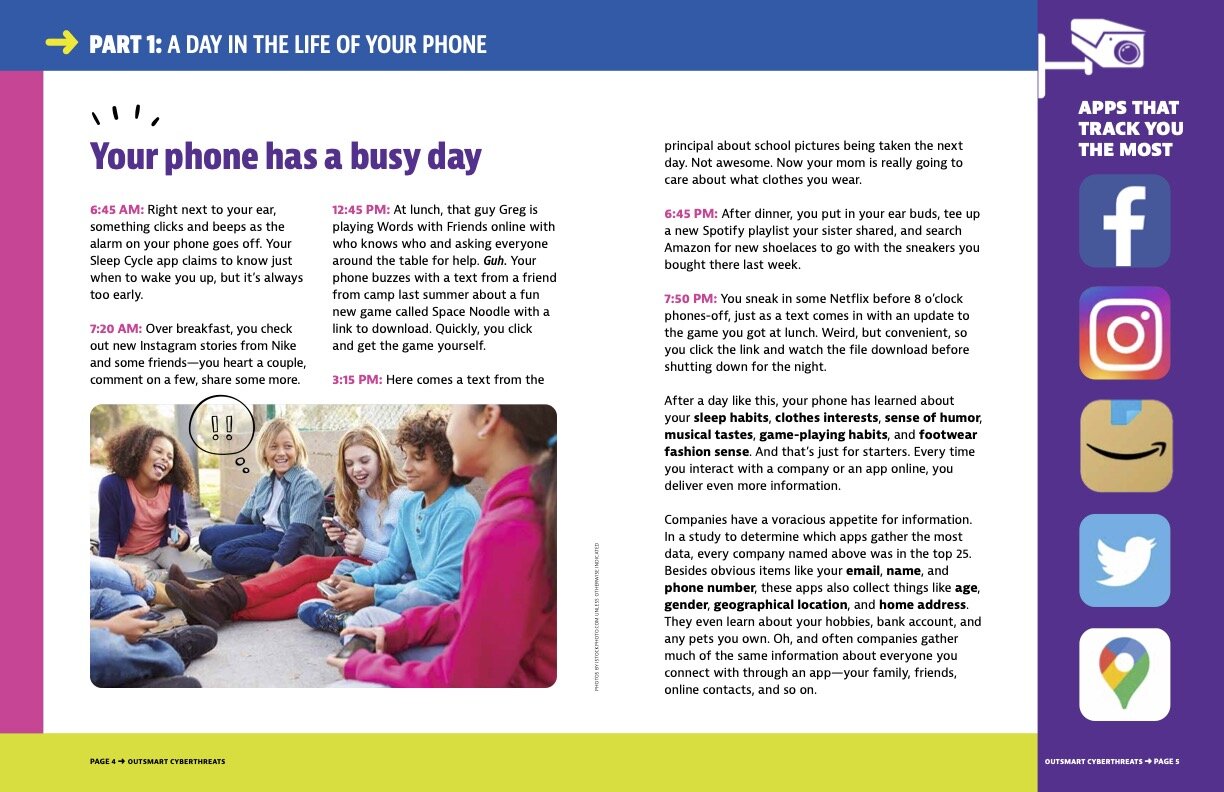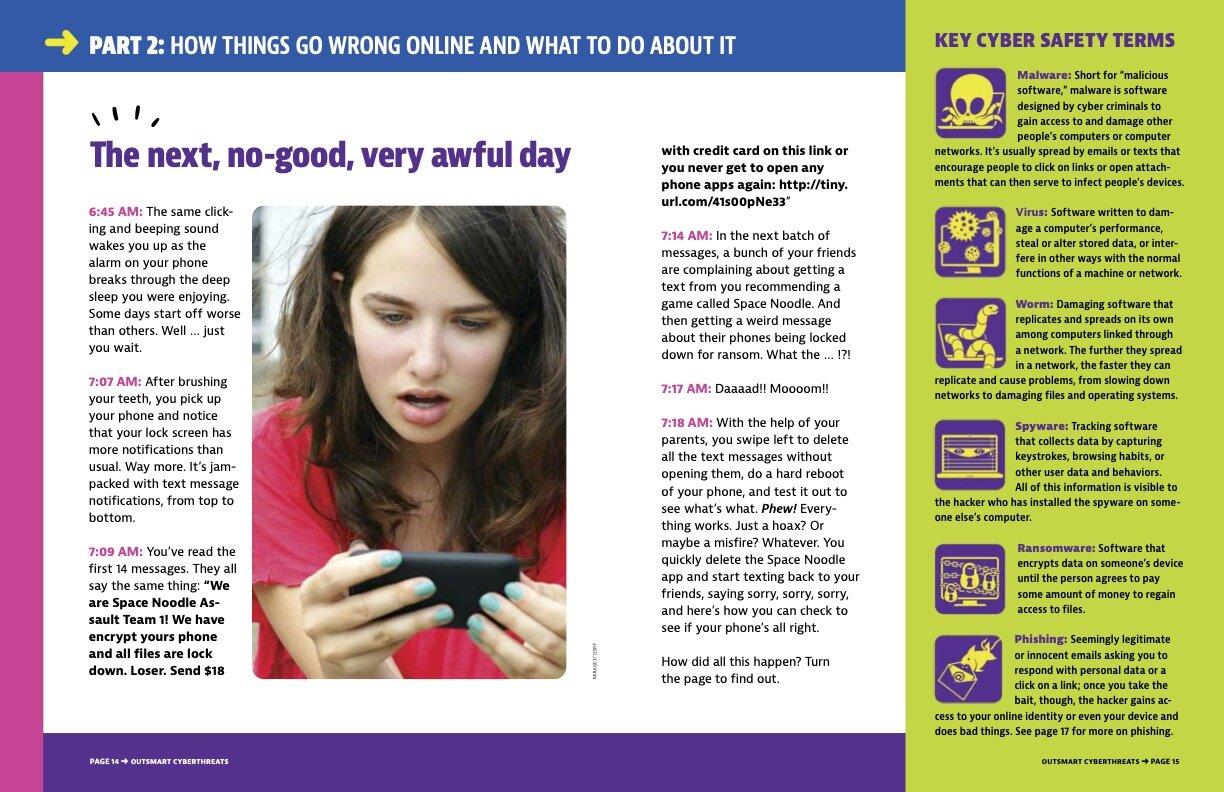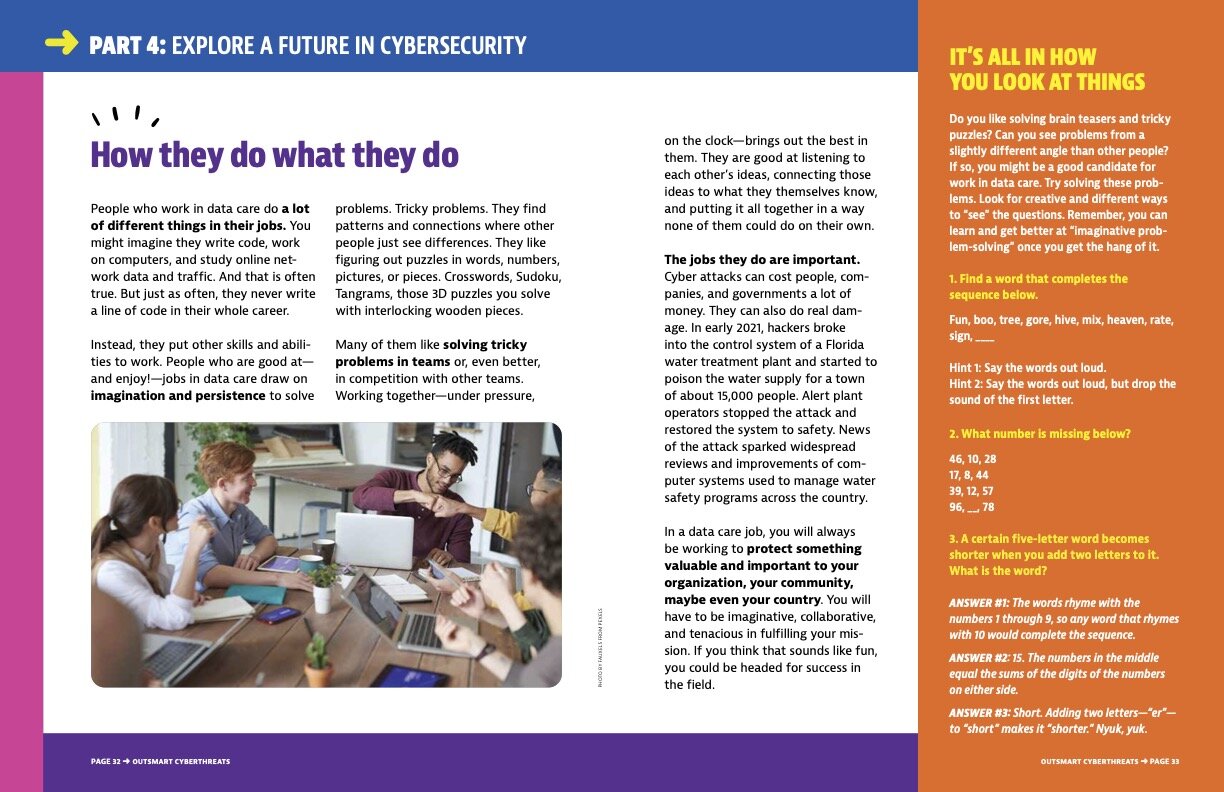Never simple
Our virtual lives get nothing if not more complicated and extensive. More and more of our work, learning, and leisure takes place online, a phenomenon accelerated by COVID but well established for all ages before the onset of pandemic times. Especially for kids, getting a grip on safely navigating this ever-expanding universe of online experiences is tricky.
With Cybersecurity Awareness Month under way, we take great pride in announcing our latest publication, Outsmart Cyberthreats, in which we explore ramifying risks for underage internet users as well as offer guidance for how they can avoid these risks. Along the reading way, students will also find an accessible, engaging introduction to what professionals do in cybersecurity that can show them how their skills and interests might align with career pathways in the field; more on this below.
Same old, same old
Many of the risks associated with kids going online are familiar. As we all know, social media platforms plus kids’ limit-testing behaviors can equal trouble – embarrassment at least and possibly worse both now and in the future. The infamous 2014 leak, for example, of illegally saved Snapchat images released over 100,000 images of nude teenagers, almost all under 18, into the digital wild.
Like everyone else, teens will have their data harvested in much greater volumes than they might realize or expect. As studies show, companies are voracious in gathering and monetizing user data, but nobody should need a study to know this. The personalized ads that follow us around the internet should be all the proof we need of the constant surveillance that attends our every move online.
Add in the garden-variety scams that litter our screens via email, pop-up boxes, and booby-trapped websites, and kids face regular, unpredictable peril at unmarked turns all over the internet.
But also …
Above and beyond these immediate risks, kids face other online dangers that no attention to individual behaviors can mitigate. For example, their school data environments are choice targets for identity thieves because K-12 security measures tend to be less stringent than in other industries. The problem, though, more often lies with third-party contractors and service providers who plug into schools’ systems. In 2019, for example, one of the biggest testing service providers, Pearson, was the gateway to a hack of 13,000 schools and millions of student records.
When kids’ personally identifiable information, or PII, gets misappropriated like this, it can have ramifications that take years to come to light. Cyber criminals value kids’ PII because it can enable “synthetic identity fraud,” the creation of false identities online using kids’ real data as cover for theft and fraud. Over one million kids were victims of such fraud in 2017. Only later, when kids get old enough to need a credit report – for student loans, a job application, credit of any kind – does the fraud necessarily come to light. Despite having no actual financial history, the child’s credit report can show lengthy, often criminal behaviors in their name.
Such risks result from nothing kids ever do themselves with their own data. Data breaches can harm anyone, but while adults might have protections or safeguards in place for their own online financial affairs, kids almost always do not. Pairing data with the fact of being underage puts kids at risk in both online and offline environments.
Awareness and education
Making kids aware of these risks should be much on our minds, especially this month during Cybersecurity Awareness Month. And abundant resources are readily available for adults to help understand and explain these risks – the primary government sponsor of this month’s efforts is CISA, the Cybersecurity and Infrastructure Security Agency. Their resource kit is a model of accessibility, clarity, and comprehensiveness.
Programming in the third week of October focuses on cybersecurity career awareness, an effort led by NICE, the National Initiative in Cybersecurity Education. Once kids understand how the mere act of going online puts their current and future selves at risk, they might well develop motivation to try and improve things for themselves and other internet users by building a career in cybersecurity. Resources and activities gathered and staged via NICE’s tireless organizing efforts paint a full picture of why careers in cybersecurity should appeal to students of all kinds, no matter what background or interests they might bring to the question.
Getting smart about cyberthreats
These combined imperatives of, 1) educating kids about risks to their data online and, 2) illustrating the opportunities available to them in jobs related to mitigating these risks animate, 3) our latest publication, Outsmart Cyberthreats. Designed for middle-school audiences, it’s a 40-page presentation of what can go wrong with kids’ data online and what kinds of jobs kids might consider that can put them in a position to make things go right as cybersecurity professionals. Click through the gallery below to see learn more.
First and foremost, the book teaches kids how to be safer online. By tracking the (mis)adventures of a tween whose phone becomes a conduit for malware, the book explores how our data gets harvested, monetized, breached, and abused. Lessons in passwords, online scams, and risky websites undergird discussions of broader issues like data security, trust online, and assessing risk. And the book finishes up with an exploration of career opportunities in cybersecurity, emphasizing the breadth of opportunity for students of all backgrounds and interests.
The backstory
We developed this book in partnership with the National Cryptologic Foundation and in support of a broad campaign to promote “data care” awareness and careers, funded generously by the Gula Tech Foundation. Already set for distribution in print to every middle school in Maryland, the book is also available in digital format or for sale on our website.
And, finally
If you have any comments or questions about the book, or “data care” in general, please be in touch. The concept offers a broader lens for thinking about the choices and responsibilities we all face in going online. And it opens up new ways to connect career options to opportunities in cybersecurity. Outsmart Cyberthreats explores these questions for middle schoolers, but they are relevant to every user of the internet.
Eric Iversen is VP for Learning and Communications at Start Engineering. He has written and spoken widely on STEM education and related careers. You can write to him about this topic, especially when he gets stuff wrong, at eiversen@start-engineering.com.
You can also follow along on Twitter @StartEnginNow.
Our newest book is Outsmart Cyberthreats. It teaches middle schoolers about online security and points them towards meaningful, rewarding career pathways.
The award-winning 2nd edition of Cybersecurity Career Guide shows high schoolers what cybersecurity is all about and how they can find the career in the field that’s right for them. Now with an updated Student Workbook and new Teacher’s Guide for classroom or afterschool use!
To showcase STEM career options, pair our cybersecurity books with the updated 3rd edition of our Engineering Career Guide.
We’ve also got appealing, fun engineering posters and engaging books for PreK-2 and K-5.
Our books cover the entire PreK-12 range. Get the one that’s right for you at our online shop.






